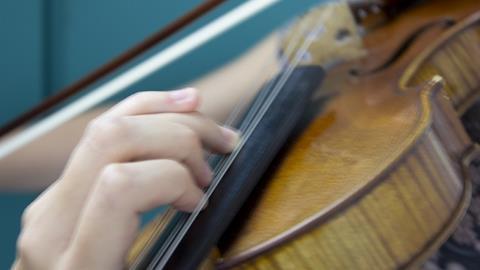Tips from The Strad’s archive on producing even and finely tuned double-stops

The reason why the study of double-stops is so highly advantageous for the progress of the student may be found in its great technical and musical value, which can be distinguished in four directions:
1. All possible faults regarding holding of the hand and placing of the fingers are here conspicuously exposed; double-stopping represents an excellent corrective of such faults and an infallible means of training the correct position of hand and fingers.
2. It teaches further the relation of stops between two string (intervals), furthering thus a thorough knowledge of the fingerboard as well as fingering.
3. It exacts great strengths, not only that of gripping, but in many cases of individual hammer-strength of each finger.
4. Finally it provides an excellent and indispensable training of the ear, as regards purity of intonation, as well as beauty of sound.
As regards the hand-position, the hand should be sufficiently raised so that the fingers may be well rounded, stopping one string without touching the other. In normal stretch this is comparatively easy, unless the fourth finger here is well founded and standing on its tip, it will easily touch the A string and thus spoil the upper note.
Emil Krall, The Strad, May 1915
Three key points to watch playing in thirds are:
1. Position the hand slightly more in favour of the upper finger of each third than the lower finger, and reach back with the lower finger. Do not base the hand position on the lower finger, stretching the upper finger forward.
2. To play a double-stop at the same volume as a single-stop you have to play twice as heavily with the bow, but the fingers should still stop the strings lightly.
3. If there is tension in the fourth finger, release it by relaxing the base knuckle joint of the first finger.
Simon Fischer, the Strad, September 1996
Folk fiddle tunes with an E or A string drone are great tools for forcing students to bring their hands up and over the fingerboard, curving their fingers so as not to stop the open string and setting the left-hand fingers correctly.
Laura Reed, The Strad, September 2002
Many players find scale passages in thirds particularly difficult to play in tune. There are frequent changes of position and to complicate matters further the intervals are sometimes major and sometimes minor. If we study the movements of the left hand in a typical passage, such as the G major scale, we find that the principal difficulty is to control the spacing of the 1st and 3rd fingers at a change of position. As the hand slides to the new position these fingers remain on the strings, and they must be set to the correct spacing for the upper interval during the progress of the slide itself. While slight final adjustments may be made ‘by ear’ to secure exact intonation, it is important to bring the fingers as nearly as possible to the correct stops before the interval is sounded at all. During the shift the finger spacing between fingers 1 and 3 should remain precisely constant.
Dr H.R. Allan, The Strad, On Playing Thirds in Tune
When playing double-stops, it is essential to keep the hand and fingers as soft and free as they are when playing the simplest single notes – in other words, as free as they are when you are not even playing the violin. Doing mobility exercise is a good way to discover how to give and release, in the hand and fingers, while still maintaining enough muscle tone to play. When playing in octaves, one of the most important elements is that the entire left hand is free of tension. A chief cause of tension comes from not releasing between octaves, which is like pedalling a bicycle while continuing to squeeze the brakes.
Simon Fischer, The Strad, April 2008 and November 2013
When children play with a poor quality of tone on double-stops, it is usually because the angle of the bow is not correct and one string is getting more pressure from the bow than is the other string.
Elizabeth A.H. Green, The Strad, September 2002











































No comments yet